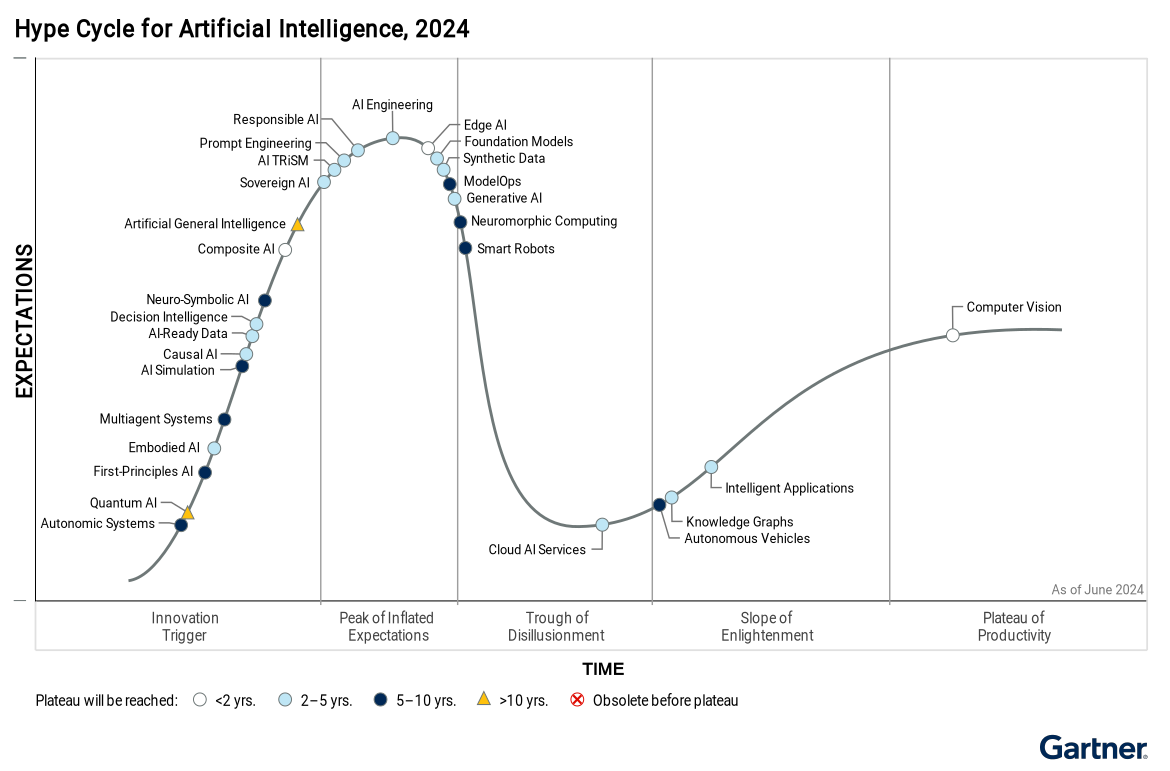It’s easy to get swept up by the excitement surrounding emerging technologies like generative AI, especially when the buzz from media, industry reports, and high-profile success stories is everywhere. Companies are rushing to adopt tools and AI-driven solutions to gain a competitive edge and transform their operations. While these innovations are undeniably powerful and have a place in many industries, they are not one-size-fits-all.
Generative AI is a class of artificial intelligence that creates new data, including images, text, audio, or video, similar to but not the same as existing data. These AI models learn the patterns and structures of a given dataset and use this knowledge to generate new examples that resemble the original data. In other words, generative AI teaches machines to create something new by learning from what already exists.
It created a ton of buzz these past two years, leading industries everywhere down information rabbit holes hoping to find ways to harness it. Unfortunately, many companies that attempted to implement generative AI into their businesses did not have a positive outcome. An Apple News article indicated the drawbacks: “Large language models like ChatGPT are prone to hallucinating and spreading misinformation. Both chatbots and AI image makers have been accused of plagiarising writers and artists. And overall, the hardware that generative AI uses needs enormous amounts of energy, gutting the environment”.
The article provided a few examples of where generative AI failed, including:
- A UK company was forced to turn off its chatbot after it started swearing at customers and trash-talking employers.
- A California car dealership was also forced to disable its ChatGPT salesman after it started offering buyers $1 cars.
- An airline was ordered to pay damages after its chatbot misled a customer trying to obtain a bereavement discount for a flight to attend a funeral.
Another article from Breaking Defense offers insight into the maturity levels of generative AI used in ChatGPT. It explains why they will continue testing it instead of implementing it in its current state. Among the reasons listed are results riddled with hallucinations and the dangers of implementing such outputs.
Our Senior VP of data science also weighed in, stating that generative AI is moving too quickly for patenting and intellectual property protection to be relevant, with ideas and methods becoming outdated faster than the patents are published or evaluated. It is the free exchange of ideas that allows this field to progress at such a remarkable speed, and, like other fields of machine learning and AI preceding it, in 5, 10, or 20 years, this field will reach its maturity and become commoditised, and then will be superseded by new architectures, methods, and capabilities. However, entities that fail to understand the benefits and shortcomings of this technology today will find themselves at a disadvantage in the near future.
It’s essential to exercise caution when following AI trends and to research and consider your business use case thoroughly.
According to Gartner’s 2024 hype cycle, generative AI has passed the Peak of Inflated Expectations. While we still see lots of hype about it and significant investments in it, it still has yet to deliver business value, as the earlier cases demonstrate. Generative AI may not be the answer to everything; nevertheless, this does not necessarily mean that it is entirely ineffective.
Gartner’s previous report highlighted that the generative AI movement, towards more powerful AI systems has two sides.
-
Innovations that will be fueled by GenAI.
-
Innovations that will fuel advances in GenAI.
The increasing popularity of GenAI offerings and applications like ChatGPT, MidJourney, and Stable Diffusion has led to a surge in industries exploring the use of generative AI. While we can expect to see more of these experiments, it’s important to note that other mature and reliable forms of AI can also solve business problems.
Hype Cycle for Artificial Intelligence, 2024
According to Gartner’s 2024 Hype Cycle, generative AI has passed the Peak of Inflated Expectations, and despite the ongoing buzz, its value for most organisations remains to be fully realised. As businesses explore AI solutions, it’s important to take a measured approach—focusing not just on what’s trending, but on what will actually drive value based on your organisation’s unique needs, data maturity, and operational readiness.

Approaches from each source offer their own set of advantages, including reputational impacts, risk mitigation, scalability, and more. The following list provides an overview of each stage and the benefits of combining approaches.
Early Innovation (Innovation Trigger and Peak of Inflated Expectations)
- Cutting-Edge Solutions: Leveraging innovations at these stages allows access to the latest and potentially most transformative technologies.
- Competitive Advantage: Getting in early can give you a major competitive advantage in standing out in the market.
- Visionary Leadership: Demonstrates a commitment to forward-thinking and innovation, enhancing brand reputation and attractiveness to talent and investors.
Mid-Stage (Trough of Disillusionment and Slope of Enlightenment)
- Balanced Risk: Combining early-stage innovations with mid-stage technologies helps balance the risks, as the latter have moved past initial hype and disillusionment.
- Learned Insights: Technologies in these stages come with lessons learned from early adopters, reducing the likelihood of common pitfalls and guiding more practical implementations.
- Improved Usability: Mid-stage innovations often have improved usability and practical applications, making integrating and generating value easier.
Mature Stage (Plateau of Productivity)
- Proven Effectiveness: Technologies at this stage have demonstrated their value and effectiveness, offering reliable solutions for business processes.
- Stable Ecosystem: Mature technologies have a stable ecosystem, which includes robust support, extensive documentation, and a community of users.
- Scalability: These technologies are often highly scalable, enabling broader and more seamless integration across various business functions.
Holistic Benefits of Combining Approaches
- Comprehensive Solutions: Integrating innovations from all stages allows for creating more comprehensive and versatile solutions that address current and future needs.
- Optimised Investment: Balancing investments across different stages can optimise resource allocation, avoiding overcommitment to unproven technologies while capitalising on new opportunities.
- Adaptive Strategy: A mixed approach enhances organisational agility, enabling a more adaptive and resilient strategy that can quickly pivot in response to technological advancements and market changes.
- Synergy and Innovation: Combining diverse innovations can create synergistic effects, leading to novel applications and breakthroughs that might not emerge from focusing on a single stage.
By strategically combining technologies from various points in the Gartner Hype Cycle, organisations can leverage the benefits of each stage while minimising their drawbacks. This approach enables continuous innovation and a competitive edge. Additionally, it helps address data and operational maturity, two important factors to also consider when implementing AI technology.
Data and Operational Maturity
Data and operational maturity are crucial for an organisation to effectively utilise technology. When developing an innovation plan, it’s important to assess where your organisation stands in each area. The following information can provide insights to help you understand these categories better.
Data Maturity
Data maturity refers to an organisation’s ability to manage, analyse, and use data effectively. It involves the development and optimisation of data-related processes, technologies, and skills over time. The levels of data maturity typically include:
- Ad Hoc:
- Characteristics: Data is managed on an as-needed basis with no formal processes or standards.
- Challenges: Inconsistent data quality, lack of governance, and limited ability to derive insights.
- Foundational:
- Characteristics: Basic data management practices, including data collection and storage, are established.
- Challenges: Data silos, limited integration, and basic analytical capabilities.
- Managed:
- Characteristics: Standardised data management processes, improved data quality, and integration across systems.
- Capabilities: More reliable reporting and basic descriptive analytics.
- Advanced:
- Characteristics: Proactive data governance, advanced data integration, and use of data warehousing and business intelligence tools.
- Capabilities: Advanced analytics, predictive modelling, and data-driven decision-making.
- Optimised:
- Characteristics: Real-time data processing, extensive use of machine learning and AI, and a culture of continuous improvement.
- Capabilities: Prescriptive analytics, real-time decision support, and autonomous systems.
Operational Maturity
Operational maturity refers to the extent to which an organisation has developed its operational capabilities, processes, and systems to achieve efficiency, effectiveness, and scalability. The levels of operational maturity often include:
- Initial/Ad Hoc:
- Characteristics: Processes are informal, unstructured, and reactive.
- Challenges: High variability, lack of consistency, and inefficiencies.
- Repeatable:
- Characteristics: Basic processes are established and can be repeated with some consistency.
- Capabilities: Increased predictability and reduced variability in outcomes.
- Defined:
- Characteristics: Standardised and documented processes that are understood and followed across the organisation.
- Capabilities: Improved coordination and more reliable performance.
- Managed:
- Characteristics: Processes are measured and controlled, with performance metrics and KPIs in place.
- Capabilities: Enhanced ability to monitor, manage, and optimise operations based on data-driven insights.
- Optimised:
- Characteristics: Continuous improvement through feedback loops, advanced automation, and innovation.
- Capabilities: High efficiency, agility, and adaptability to changing conditions and opportunities.
Intersection of Data and Operational Maturity
When both data and operational maturity are high, organisations can reap considerable benefits that include:
- Data-Driven Operations: High data maturity enables real-time, data-driven decision-making in operational processes, leading to greater efficiency and responsiveness.
- Enhanced Analytics: Mature operations provide the structure and discipline needed to effectively implement and scale advanced analytics and AI solutions.
- Improved Innovation: Organisations with the data and operational infrastructure to support experimentation and scaling can more effectively pilot and integrate innovations from all stages of the Hype Cycle.
- Strategic Agility: High maturity levels in both domains allow organisations to adapt rapidly to new opportunities and challenges, maintaining a competitive edge in a dynamic market.
By continuously advancing data and operational maturity, organisations can fully leverage technological innovations, optimise performance, and drive sustained growth and innovation.
Linking data and operational maturity to the stages of Gartner’s Hype Cycle
Moreover, linking data and operational maturity to the stages of the Gartner Hype Cycle helps to understand how organisations can effectively leverage innovations at each stage. Here’s how they relate:
Innovation Trigger
- Data Maturity: At this stage, organisations with lower data maturity might struggle to integrate nascent technologies due to poor data quality and a lack of foundational data management practices. Organisations with higher data maturity can better experiment with new technologies, using their structured data to pilot innovations and derive early insights.
- Operational Maturity: Organisations at higher operational maturity can more efficiently incorporate and test early-stage innovations within their established processes, leading to faster and more effective experimentation and feedback loops.
Peak of Inflated Expectations
- Data Maturity: Higher data maturity allows organisations to critically evaluate the performance and potential of hyped technologies using robust data analytics. This reduces the risk of overcommitting to technologies based on hype rather than evidence.
- Operational Maturity: Mature operational processes ensure that while exploring new technologies, organisations can maintain operational stability and manage risks associated with overhyped solutions.
Trough of Disillusionment
- Data Maturity: Organisations with mature data capabilities can analyse performance data to identify why certain innovations have failed to meet expectations. This helps them make informed decisions about whether to abandon or refine the technology.
- Operational Maturity: High operational maturity allows organisations to pivot or adjust their approach to implementing new technologies without significant disruption, learn from early adopters’ mistakes, and improve integration strategies.
Slope of Enlightenment
- Data Maturity: As technologies demonstrate real-world benefits, organisations with advanced data maturity can maximise these benefits through deeper analytical insights and more sophisticated data utilisation.
- Operational Maturity: Mature operations can better scale the deployment of technologies that are proving their value, ensuring they are integrated efficiently and effectively across the organisation.
Plateau of Productivity
- Data Maturity: At this stage, technologies have become mainstream. Organisations with optimised data maturity can leverage these mature technologies for advanced analytics, predictive modelling, and even AI-driven autonomous systems, deriving maximum value.
- Operational Maturity: Mature operational processes ensure that these well-established technologies are fully integrated, leading to improved efficiency, scalability, and innovation. Continuous improvement practices enable ongoing optimisation and refinement.
Computer vision has consistently remained at the Plateau of Productivity in recent Gartner hype cycles, indicating that it is ready for implementation.
Computer vision is a field of AI that allows computers and systems to interpret and understand the visual world. By utilising digital images from cameras, videos, and deep learning models, machines can accurately identify and categorise objects and respond based on their visual input. Here are some key aspects:
- Image Processing: This involves manipulating digital images to enhance them or extract information. Techniques include filtering, image transformation, and edge detection.
- Object Detection: The process of identifying and locating objects within an image or video frame. It involves recognising what objects are present and determining their positions.
- Object Recognition: A more specific form of object detection in which the system identifies what the objects are, categorising them into predefined classes (e.g., identifying a dog, a car, or a tree).
- Facial Recognition: A technology used to identify or verify a person from a digital image or video frame. It involves recognising facial features and matching them against a database of known faces.
- Image Segmentation: The process of dividing an image into segments to simplify its analysis. Each segment typically represents a meaningful part of the image, such as an object or a region.
- Optical Character Recognition (OCR): The process of converting different types of documents, such as scanned paper documents, PDFs, or images captured by a digital camera, into editable and searchable data.
- Motion Analysis: The study of moving objects in a sequence of images or video frames. It is used in applications like surveillance and sports analysis.
- 3D Vision: Understanding the three-dimensional structure of a scene. This includes depth estimation, 3D reconstruction, and understanding the spatial arrangement of objects.
Combining technology, maturity, and Aicadium expertise to drive real-world impact
By integrating computer vision with other technologies and considering data and operational maturity, organisations can achieve practical AI applications, including detection, classification, tracking and counting, defect detection, image generation, and more. However, it is essential to acknowledge the progression of AI technology from rules-based learning to today’s generative AI.
This continuous evolution demonstrates how new techniques evolve and combine with previous technologies to achieve real-world value and practicality. It is also crucial to become familiar with the different AI options available and to know when to seek help from a team of experts to make further progress. In summary, remember to:
-
Not get too caught up with the latest trending shiny topic in AI, as not all AI technologies are suitable for your specific problem and environment
-
Educate yourself on the various options available to you, their maturity levels, and how they’re used
-
Properly define your organisation’s use cases and pain points, taking note of their value and who in your organisation is involved
-
Take note of your data and operational maturity, as these factors are critical to determining whether or not your organisation is ready for certain technologies
-
Know when it’s time to reach out for expert help.
To successfully leverage AI, avoid blindly following the latest trends. Instead, focus on understanding your business requirements, exploring the full range of AI technologies available, and assessing your organisation’s data and operational maturity. Combining these insights and working with the right experts when needed allows you to select and implement AI solutions that deliver real, sustainable impact.
At Aicadium, we understand how big of a decision you have before you — a decision that requires trial and error of various offerings — and as you go through this process, you may uncover deeper layers of your problems that reveal their complexity. This complexity can arise due to various factors that include:
-
Foundational data problems
-
Physical space constraints
-
Hardware issues
-
Staff and skill shortages
-
and so on…
When you uncover those problems and find yourself in a situation where none of the available options works for you, we’ll be waiting on the other side, equipped with our AI-powered computer vision application, Aicadium View™.
Aicadium View™ is an advanced AI-powered computer vision application for industrial companies dedicated to improving their inspection, productivity, and quality control processes. Our flagship product allows us to build strong partnerships with clients, better understand their pain points and deliver a user-friendly application that meets their needs. With Aicadium View™, companies can achieve continuous growth, improvement, and enhancement of their inspection processes.





